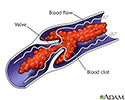Congenital antithrombin III deficiency
Deficiency - antithrombin III - congenital; Antithrombin III deficiency - congenital
Congenital antithrombin III deficiency is a genetic disorder that causes the blood to clot more than normal.
Genetic
Genetics is the study of heredity, the process of a parent passing certain genes to their children. A person's appearance -- height, hair color, ski...

Causes
Antithrombin III is a protein in the blood that blocks abnormal blood clots from forming. It helps the body keep a healthy balance between bleeding and clotting. Congenital antithrombin III deficiency is an inherited disease. It occurs when a person receives one abnormal copy of the antithrombin III gene from a parent with the disease.
The abnormal gene leads to a low level of the antithrombin III protein. This low level of antithrombin III can cause abnormal blood clots (thrombi) that can block blood flow and damage organs.
People with this condition will often have a blood clot at a young age. They are also likely to have family members who have had a blood clotting problem.
Symptoms
People will usually have symptoms of a blood clot. Blood clots in the arms or legs usually cause swelling, redness, and pain. When a blood clot breaks off from where it formed and travels to another part of the body, it is called a thromboembolism. Symptoms depend on where the blood clot travels to. A common place is the lung, where the clot can cause a cough, shortness of breath, pain while taking deep breaths, chest pain, and even death. Blood clots that travel to the brain can cause a stroke.
Exams and Tests
A physical exam may show:
- A swollen leg or arm
-
Decreased
breath sounds in the lungs
Breath sounds in the lungs
Breath sounds are the noises produced by the structures of the lungs during breathing.
 ImageRead Article Now Book Mark Article
ImageRead Article Now Book Mark Article - A rapid heart rate
- Weakness in the arms or legs (if the blood clot caused a stroke)
The doctor can also order a blood test check if you have a low level of antithrombin III.
Blood test
Antithrombin III (AT III) is a protein that helps control blood clotting. A blood test can determine the amount of AT III present in your body....
Treatment
A blood clot is treated with blood thinning medicines (also called anticoagulants). How long you need to take these drugs depends on how serious the blood clot was and other factors. Discuss this with your health care provider.
Outlook (Prognosis)
Most people have a good outcome if they stay on anticoagulant medicines.
Possible Complications
Blood clots can cause death. Blood clots in the lungs are very dangerous.
When to Contact a Medical Professional
See your health care provider if you have symptoms of this condition.
Prevention
Once a person is diagnosed with antithrombin III deficiency, all close family members should be screened for this disorder. Blood thinning drugs can prevent blood clots from forming and prevent complications from clotting.
References
Anderson JA, Weitz JI. Hypercoagulable states. In: Hoffman R, Benz EJ Jr, Silberstein LE, Heslop HE, Weitz JI, Anastasi J, eds. Hematology: Basic Principles and Practice . 6th ed. Philadelphia, PA: Elsevier Saunders; 2013:chap 142.
Schafer AI. Thrombotic disorders: Hypercoagulable states. In: Goldman L, Schafer AI, eds. Goldman's Cecil Medicine . 25th ed. Philadelphia, PA: Elsevier Saunders; 2016:chap 176.
-
Venous blood clot - illustration
Deep venous thrombosis (DVT) affects mainly the veins in the lower leg and the thigh. It involves the formation of a clot (thrombus) in the larger veins of the area.
Venous blood clot
illustration
Review Date: 2/13/2015
Reviewed By: Rita Nanda, MD, Assistant Professor of Medicine, Section of Hematology/Oncology, University of Chicago Medicine, Chicago, IL. Review provided by VeriMed Healthcare Network. Also reviewed by David Zieve, MD, MHA, Isla Ogilvie, PhD, and the A.D.A.M. Editorial team.

